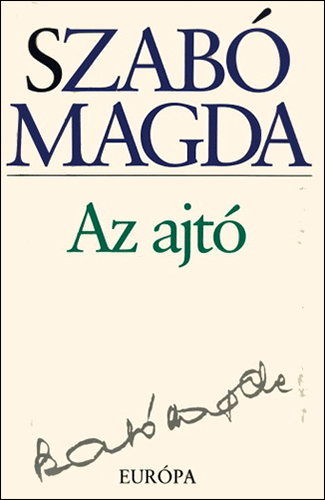65 Hungarian

Magda Szabó (1917-2007) was a Hungarian novelist, known as the most translated Hungarian author. She worked in multiple genres, including drama, poetry, short stories, and memoirs. For this exhibition, we chose her 1987 novel Az ajtó (“The Door”) for several reasons. First, she was repressed as a result of Stalinist excesses. According to a book review of another novel only recently translated into English, “her fiction shows the travails of modern Hungarian history from oblique but sharply illuminating angles.”1 Second, the complex relations between the main characters of Az ajtó: Magda, her husband, and Emerence, the woman helper with an adopted dog, juxtaposed with who is in charge and how the relationship will evolve leads to a creation of a layered narrative. The layered narrative represents a mesmerizing self-weaving quilt of time and contextual protests.2 As a young poet she won her country’s chief literary honor, the Baumgarten Prize, in 1949 even though on the same day, the communist regime cancelled this award. She lost her civil- service job, went to teach in a primary school, and only began to publish novels a decade later. Novels such as Az ajtó and Pilátus (“Iza’s Ballad”) are entangled with public upheavals from the repressive governments and Nazi occupation of the 1930s and 1940s, to the sudden annihilation of Hungary’s Jews, and the soul-sapping compromises and betrayals of the Stalinist era.
Called Magyar by its speakers, Hungarian is the language of Hungarians (Magyarok) and is the official language of the Republic of Hungary. It is spoken by over 10 million people in Hungary and also by approximately 3 million ethnic Hungarian minorities in parts of the Czech Republic, Romania, Slovakia, Serbia and other areas bordering Hungary. Hungarian belongs to the Ugric branch of Finno-Ugric languages. Hungarian also has loan words from Germanic, Slavic and Turkic groups of languages. According to Oxford’s International Encyclopedia of Linguistics International Encyclopedia of Linguistics (2nd ed.), Hungarian’s status is described as follows, “Until the end of the 18th century, the status of Hungarian in the juridical, educational, and even literary spheres was at best that of a lesser rival to Latin, and then to German. With the deliberate establishment of the standard literary language, and the prodigious output of the golden age of Hungarian belles-lettres (roughly 1780–1880), dialectal variation was winnowed out. At present, the primary internal variation lies in the contrast of rural vs. urban standard; the latter is roughly equivalent to the speech of Budapest, where one-fifth of the population resides.”3
Hungarian was also one of the principle languages of the multiethnic, multilingual Austro-Hungarian Empire since its establishment in 1801. In her essay “The History of the Book in Hungary,” Bridget Guzner notes, “The earliest Hungarian written records are closely linked to Christian culture and the Latin language. The first codices were copied and introduced by travelling monks on their arrival in the country during the 10th century, not long after the Magyar tribes had conquered and settled in the Carpathian Basin. The first incunabula known as Chronica Hungarorum (“Chronicle of Hungarians”) was published in 1473 by András Hess.”4 According to The Oxford Dictionary of the Renaissance, “Scholarly study of the Hungarian language began in 1539 with the publication of Pannonius’ Grammatica Hungaro-Latina.”5 Until the end of the 18th century, the principal language of Hungarian literature was Latin, which was the language of the markedly literary court of Matthias Corvinus. The most important writers of Latin in Hungary were János Vitéz, Pannonius (whose poetry included epigrams, panegyrics, and epics), the Italian Antonio Bonfini (who wrote an important history of Hungary, the Rerum Hungaricarum decades IV, Basel, 1568), and the Hungarian Sambucus, who wrote a continuation of Bonfini’s history. In the Hungarian language, the most influential works were a series of translations of the Bible into Hungarian. The first great lyric poet of Hungary was Valentine Bálint Balassi (1554–95).”6
At UC Berkeley, Hungarian is currently taught by Eva Szoke in the Department of Slavic Languages and Literatures, but the credit for creation of Hungarian language teaching program on campus can be given to Ms. Agnes Mihalik, who arrived at UC Berkeley in 1982. Outside the Hungarian language program, Professor Jason Wittenberg and Professor-Emeritus Andrew Janos, both from the Department of Political Science, specialize in Central and Eastern Europe with a focus on Hungary.
Contribution by Liladhar Pendse
Librarian for East European and Central Asian Studies, Doe Library
Source consulted:
- “After 50 years, a Hungarian novel is published in English,” The Economist (February 28, 2019, (accessed 6/12/20)
- “The Hungarian Despair of Magda Szabó’s ‘The Door’,” by Cynthia Zarin. The New Yorker (April 29, 2016) (accessed 6/12/20)
- International Encyclopedia of Linguistics. 2nd ed. William J. Frawley, ed. Oxford; New York: Oxford University Press, 2003. (accessed 6/12/20)
- “The History of the Book in Hungary” by Bridget Guzner in The Oxford Companion to the Book. Michael F. Suarez and H.R. Woudhuysen, ed. Oxford: Oxford University Press, 2010. (accessed 6/12/20)
- The Oxford Dictionary of the Renaissance. Gordon Campbell, ed. Oxford; New York: Oxford University Press, 2003. (accessed 6/12/20)
- Ibid.
Title in English: The Door
Author: Szabó, Magda, 1917-2007
Imprint: Budapest: Magvető, 1987.
Edition: 1st
Language: Hungarian
Language Family: Uralic, Finno-Ugric
Source: Digitális Irodalmi Akadémia
URL: https://reader.dia.hu/document/Szabo_Magda-Az_ajto-889
Select print editions at Berkeley:

